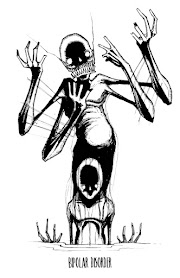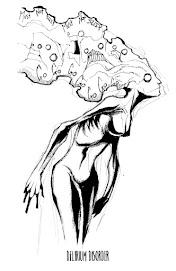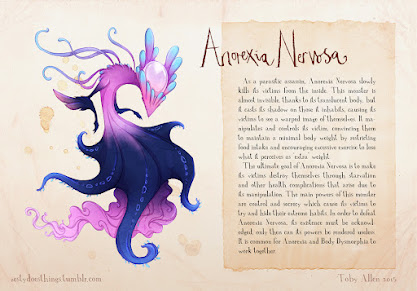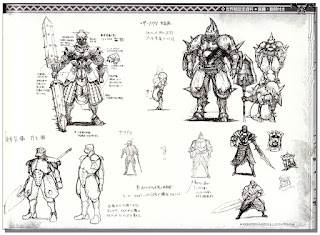Thursday, October 17, 2024
Anxiety Disorders
Friday, October 4, 2024
Mental health monsters - whats come before
I'm not going to pretend that the idea of using mental health conditions as a theme for creative practice is revolutionary and new, often being used by artists to promote awareness of the symptoms that those diagnosed as such suffer from. However, it is more common to be illustrative rather than conceptual for games or film design - and after looking at some of the following artists and ideas to get me thinking of what could be done differently to show off my own specialist skills it got me thinking back to how to tie it into a possible game if at all. Eventually, I came to think of hunting these mental health monsters, since nobody wants anyone to be suffering in this way - leading to the sort of work from the Monster Hunter franchise and how the designs of the monsters in those games are pushed forward into the designs of the armor and weapons that can be crafted from components looted from the bodies of the monsters slain. This direction would allow me to demonstrate my skills as a concept artist and illustrator with not only creature design but also attire, weapons, and props and allow observers to see how my skills can be adapted for any project in developing a game's concept art.
Here are some of the contextual research I have come across so far and my thoughts on them and how it has influenced my own processes with this project.
Shawn Coss has done multiple series' of these designs illustrating how he believes a person suffering from a particular cognitive disorder may feel in a bold black-and-white style. However this choice of style and aesthetic ties them all together a little too closely for my particular needs of representation not allowing for the uniqueness of each condition to stand out on its own, plus with being overtly human-esque in shape and form it doesn't fit with my idea of cognitive disorders being monsters we must battle - wouldn't resonate well with sufferers if I were to suggest that they were the monster all along. Incorporating more animalistic qualities and features of monsters from both myths and legends as well as fantasy would separate the cognitive disorder from humanity giving audiences a better view of the antagonistic characters these conditions should be depicted as.
Toby Allen
Toby Allen's work is definitely more in line with some of my ideas after having looked at Shawn Coss' work having the disorders illustrated as creatures, with a more fantasy element attached to them - even the choice of font used in the descriptors lends to this theme. The aesthetic of these illustrations in comparison to the previous ones does seem to be aimed at a younger audience through its use of curved forms and saturated colours, even going as far as making some of these conditions look like cute pets one would keep - this may be perfect for the audience Allen had in mind similar to Pokemon however if I am using games like the monster hunter franchise as a format for where my project could sit then having a cute monster that you intend to hunt and defeat for parts to build weapons and armour cuteness should be replaced with a more beastly aesthetic. This isn't to say there aren't components of these designs that can't be utilised, I'm unsure whether it was intentional or not but a lot of the conditions present that fit in the category of anxiety seem to have skull-like masks and I feel it would be good to have the beasts have elements like this shared across the categories, just how pokemon have fire type and water types with design elements to show this in the forms of colour, anatomy, and texture, etc. It would show the categories as a sort of evolutionary family which represents how they all affect a particular part of the brain.
Sillvi
Xallwinz
Xallwinz is a YouTuber who creates shorts using AI with prompts to make a series of images around one theme illustrated as another, in this case, both diseases and mental illnesses are depicted as demons. These came up during research simply from a Google search of mental illnesses as monsters and I thought it would be interesting to see the contrast between AI art and illustrated pieces. I disagree with AI art being art but more of a tool for collating ideas such as images for a mood board and so looking at these subjectively there are ideas and aesthetics that look interesting such as the jigsaw skin for Autism and how horrifying some of them appear to be through artistic choices that come straight from horror movies like glowing eyes, exaggerated human features like extended limbs and jaws, however with it being computer generated a lot of them are too on the nose with the depictions such as a skeletal figure for anorexia which lacks empathy for sufferers whilst in contrast, Silvi depicts how a sufferer may view themselves when they have the condition. The realism of the pieces is quite effective and the tones of colour definitely help sell these as real creatures that would be haunting to come across I feel this would be effective when depicting tangible beasts that you could hunt allowing audiences to fight back against something they are often judged for it all being in their head.
The final products (so far)
Here are all of my current pages for the concept art book deliverable as produced on the MA game design course. I am hoping to continue wo...

-
Attempting to move the project along at a quicker and more efficient pace whilst also attempting to resolve issues found within previous it...
-
Another blog post to inform on where my current projects are at and what directions I am heading in with moving forward with designs, game ...
-
Keeping the ball rolling with this project, whilst the last two creatures are being worked up to finalised concept art for the book, I'm...











































































































